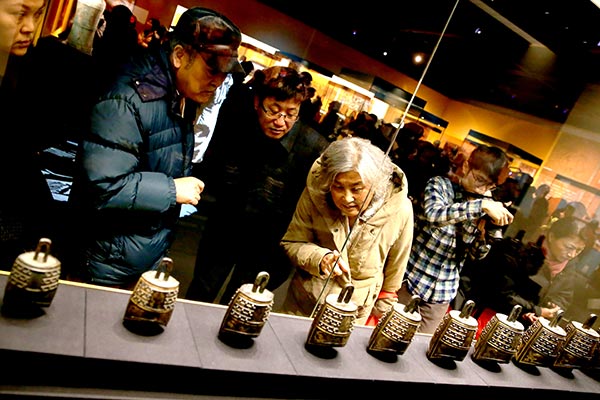 |
|
Visitors take a close look at the Chinese chimes of the Western Han Dynasty unearthed in Nanchang, capital of Jiangxi province, at the Beijing Capital Museum. The exhibition is due to close at the end of June. JIANG DONG / CHINA DAILY |
Being a historically unique and mysterious figure, the marquis died at the age of 33 and was the only victim in Chinese history who changed identities from a king to an emperor, stayed in the post for only 27 days, and was then dethroned to a king and then a marquis as a result of a political power struggle.
The marquis' tomb is currently the largest found, the best preserved with most abundant cultural treasures and most typical tomb structure of the Western Han Dynasty (202 BC-AD 8), then the most prosperous country in the world.
The richness, fine situation, superb value and complex production technology and skills of the emperor's seal, gold and silver items, jade jewelry, chariots, bells and many other items, have shocked and amazed archaeologists since the excavation began in 2011.
On show are more than 400 of the relics unearthed so far, which display the extravagancy of the lifestyle of the aristocrats and the marvel and glory of Chinese culture more than 2,000 years ago.
The six-month-long exhibition, due to close at the end of June, allows visitors to imagine how grand the national archaeological park will be when all of the relics, so far more than 20,000 pieces have been uncovered, are on display at the site of the tomb of the Haihun marquis in Nanchang.
Jiangxi authorities, who have publicized their local treasures with a holistic tourism perspective, said they have proposed to the central government to apply for the ancient site as a World Cultural Heritage site. And they are learning from Italy's experience in repairing the Pompeii historical site, which has attracted thousands of visitors everyday since it was rebuilt last year.
I think that Chinese archaeologists and the public as well, are happy to see that the Jiangxi government is thinking big with an international vision and actively preparing to build its unique historical treasure into a world-class attraction.
Prompted by years of sound economic development, China has entered the era of mass tourism. According to the 13th Five-Year Plan (2016-20), the country's total annual tourism service consumption will reach 5.5 trillion yuan ($850 billion) and urban and rural residents will each make an average of 4.5 tourism-related visits every year.
The five-year targets will not be a very big challenge as domestic enthusiasm is growing fast and total consumption hit 4 trillion yuan and investment topped 1 trillion yuan in 2015, about 10 percent of the nation's annual GDP.
But I have felt the urgency for supply-side reform by the tourism industry to cope with people's need for quality resorts and leisure services and the intensifying international competition for a bigger share in the domestic market.
The focus should be on upgrading and developing tourist attractions and services of world influence but with strong and unique Chinese characteristics. A creative marketing strategy should also be on top of the industry's agenda to promote the country's historical, cultural and natural resources and help turn them into impressive and competitive brand names.
Jiangxi's open archaeological excavation, a creative approach taken to help increase public awareness, respect and protection of history and cultural heritage, and its careful efforts and plan to tap and develop its historical resources into an archaeological research and tourism project of world recognition, can be food for thought for local governments and companies in developing and marketing their tourist resources.
According to experts from the State Administration of Cultural Heritage, excavation of the Haihun marquis tomb has been conducted with world-class heritage standards and advanced protection engineering technology, which is making a sound foundation for a great national park. Construction is expected to begin later this year and be completed in five years.
I expect public interest in the Haihun marquis tomb will grow along with new surprises from the ongoing archaeological excavation, and the building of the national park, "China's Pompeii", will eventually attract massive numbers of tourists to Jiangxi.
